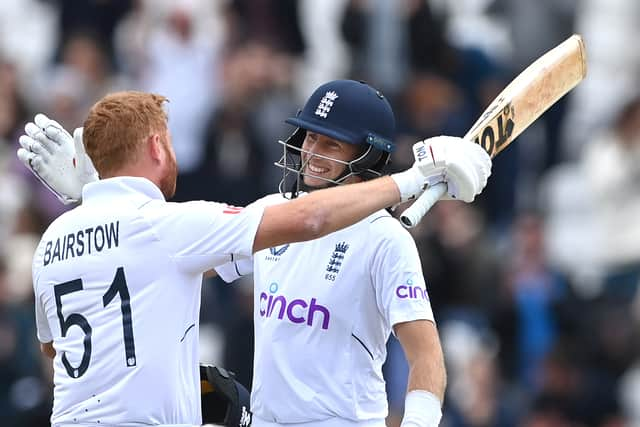England v New Zealand: is white-ball Test cricket approach the secret to England’s 3-0 success?
and live on Freeview channel 276
England secured their first home series whitewash win in nine years after they easily chased down New Zealand’s 296 to seal the deal.
England’s Test team have had a shocking time in the past 18 months but the ‘new-era’ so widely discussed with a new captain, coach and managing director is finally showing a change that has never felt so welcome.
Advertisement
Hide AdAdvertisement
Hide AdBen Stokes was handed the reins shortly before the New Zealand series started and spoke of how he wished to turn his own traumas in cricket into on pitch triumphs - it would seem as if that is exactly what he has done.
The field saw a complete reversal in attitude that saw England attack aggresively rather than sit back and hold out, and this has now lead to three remarkable run-chasing victories.
England now don’t have long to enjoy their most recent successes before their rescheduled Test against India, but they will hope to gain monemtum from their triumphs as they take on Rohit Sharma and his squad later this week.
One of the biggest take aways from this recent series has been the aggression in the final innings.
Advertisement
Hide AdAdvertisement
Hide AdLast year, England did not even attempt to chase down the 273 target New Zealand set at Lord’s, letting the game slowly trickle into a draw instead.


However, this year, we saw England chase down 277, 299 and 296 in their three Test series, seemingly making light work out of all of it.
Jonny Bairstow was the star man for both run chases in Trent Bridge and Headingley and his efforts highlight one of the other strong changes in the new-era attitude: is white-ball style cricket the way forward now?
The Yorkshireman, who was hung out to dry just a few years ago, scored 394 runs off just 328 balls this series and swatted 51 fours and 10 sixes as he secured victory in both matches north of London.
Advertisement
Hide AdAdvertisement
Hide AdThe 32-year-old also racked up an incredible strike rate of 120.12 as he went on to score two centuries and another half-century.
Joe Root secured England’s first series win in a much more Test-like fashion, scoring the vital 115 not out off 170 guiding his team safely home - but not without the odd flamboyant shot or two.
When it was time for Bairstow to step up to the mark, he went on to score England’s second fastest hundred in a Test match and seemed to give away the secret to England’s recent success: why play traditional Test style cricket when you win matches with an entertaining, all-guns blazing white-ball approach?
The focus over recent years has definitely shifted to placing greater emphasis on white-ball cricket, with England themselves being much more successful in that field than when the red-ball is in hand.
Advertisement
Hide AdAdvertisement
Hide AdNow, it seems Brendon McCullum is using this to his advantage by encouraging players to utilise their ruthlessly sharpened and perfected one-day skills in Test matches.
Whether this technique will work against such a historically strong Test side as India remains to be seen, but why change a system that is working well at present?
While it was Bairstow who showed off his white-ball skill at Trent Bridge and Headingley, it is hardly that surprising that Ben Stokes is backing such a technique.
After all, the new England captain shone in 2019 by leading the side to their first ever ODI World Cup win as well as dragging England over the edge at Headingley in the Ashes Test match by batting white-ball style.
Advertisement
Hide AdAdvertisement
Hide AdIt seems inconceivable that such a stance can be sustainable. White-ball cricket is evidently a much-faster pace format, requiring a constant stream of hard-hitting boundaries - a feat that seems unfeasible to go the distance of a five day match.
Additionally, there is also an inconsistency between England’s batting ideas and their bowling philosophies.
With the likes of Stuart Broad, Jack Leach and James Anderson still in the squad, it is clear the bowling strategy is in keeping with the Test format - set up those wicket-taking opportunites while keeping the run-rate low, with reliable, metronomic line and length deliveries.
When Jofra Archer, Saqib Mahmood and Chris Woakes all find themselves fit enough to bowl again, who can say whether the bowling strategies too will slip into white-ball style.
Advertisement
Hide AdAdvertisement
Hide AdHowever for now, with the two veterans of Broad and Anderson well placed within the squad, it seems the disjoin between bowling and batting is set to remain.
What this seemingly white-ball technique has done is given England a winning attitude, an attitude that says ‘no matter the score, we will chase it down’ and this positivity has been a much needed refresher in a team that has been in a dark, depressive zone for far too long.
With just a few days to go before England’s next Test match against another fierce opposition, Ben Stokes and his squad are in a solid position to build on what they have miraculously accomplished in the past month and continue to provide exceptional entertainment to their adoring Barmy Army.
England vs India starts on Friday 1 July 2022 at 11am BST. Sky Sports Cricket will have the live coverage from Edgbaston, Birmingham.
Comment Guidelines
National World encourages reader discussion on our stories. User feedback, insights and back-and-forth exchanges add a rich layer of context to reporting. Please review our Community Guidelines before commenting.
